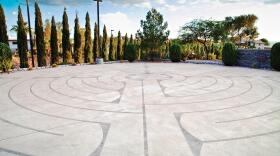“We wanted all the materials to be quiet,” architect Henry “CJ” Hoogland says as he walks through the high-end home he designed for a couple in the Ridges neighborhood. Quiet isn’t one of usual attributes that leap to mind when you think of architecture. Form, space, scale, balance, materiality, flow — sure. But if you can afford a custom home, a space designed to answer the fundamental question How do I want to live?, then quiet can be an architectural element. Hoogland mentions it often:
“This was an opportunity for us to keep the landscape really … quiet.”
“We tried to do away with the wall acne so that the architecture is quiet.” (Wall acne: switches, plugs, etc.)
Not surprisingly, the house reflects its designer: restrained, intelligent, modern, with an element of, yes, quiet drama. (That may also describe the clients, who aren’t here.) On a street of custom homes that, for the most part, look like conventional visions of residential opulence, this one stands out for its hushed poise. But there are different volumes of quiet. Check the copper element that rises to define the front roofline before flowing around back. Dramatic, in its way. Inside, in the living room, where floor-to-ceiling windows frame a distant vista, the copper flows from outside to inside to brighten an interior wall. “You read this as an architectural element,” he says — that is, as crucial to the gestalt of the house — “not as an appliqué material” — that is, as a simple décor choice. The effect is to feel embraced, wrapped in the home. Precisely what he wanted.
This house is a series of such moments, from the front courtyard to the vanishing-edge pool, painstakingly conceived, designed and engineered to look not like a pool at all, but like a water feature — a sheet of dark, wet glass. He runs his fingers along its edge. “It can be very hard to make something deliberately quiet and simple.”
Two weeks ago, the owners lived in a pseudo-Tuscan place. “When they came to us," he says, "they said, we want to do something, quote-unquote, ‘a little different.’ We said, we don’t really do a little different from where you are now. We do modern architecture.” So began the long process of tweezing out the clients’ true needs — their kids gone, they wanted more of the house devoted to their own daily uses — and matching that with a design vision. It started with the courtyard and eventually became the serene, minimalist and, indeed, quiet home he's standing in now.
“I think he’s going to be an architect.” That was Hoogland’s mother, gifted with foresight, back when he was 5 or 6. “My mother observed how I would take things apart to figure out how to put them back together,” he says. This was in East Las Vegas, where he grew up in a household in which, if something was broken, you fixed it. Good with his hands, CJ was. “I always loved building things. I was into drawing, and building models, Legos. Before I went to college, I knew how to frame a house, how to reroof a house, how to rebuild an engine — I knew how to problem-solve.” Four years of drafting and architecture classes at the old Las Vegas High School, an undergraduate degree at Arizona State and a postgraduate degree at Rice proved his mother right. Back in Vegas, he interned with several firms, including Eric Strain’s Assemblage Studio, before striking out on his own a few years ago. His firm is small: two architects and a computer-modeling specialist. At any time, they have three to five projects in the works, from a modern cabin on Mount Charleston to homes in Blue Diamond.
“CJ is one of the best talents to come out of Las Vegas,” Strain says. “He is going to have to search for his own way to interpret this valley, from its geology to its entertainment icons. I believe he will find his own voice, a voice that will create some amazing architecture for this valley.”
On the high-end Ascaya development in Henderson: “We’re one of six architects selected to design an ‘inspiration home,’ one that the developer is paying to have built to set the tone for the neighborhood. We were the only local architects selected.”
Gotta ask, CJ: What kind of house do you live in? He smiles, fidgets a minute. It’s a trick question, of course, but he fields it pretty well: a suburban house, he says, stucco, red tile, all that. But, he points out, it suits his family (five children!) just fine ... for now. “They’re in the schools they need to be in,” he says. Still, as he stands in the embrace of his own luxe handiwork, the muted flair of a copper wall on one side, a pool like glass on the other, the question behind the question beckons: How do I want to live? “I wish I lived in something as nice as this,” he says, smile intact. “Someday,” he adds, “maybe I will.”








